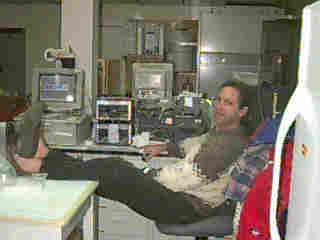
|
|
2 February, 1998
Gould-en Greetings:
Today started out very calmly with more oxygen samples to run. After
working from 7:30 until 4:30 on them , I felt I needed a break. I went up
to my favorite place on the ship -- the bridge. One can see for many miles
and in many directions on the bridge (the navigation area of the helmsman
or person "driving" the ship). I was talking with Peter about the birds
he'd seen and we were looking far to the starboard (right) side of the ship
when all of a sudden our conversation was halted by the loud puff of a
whale exhaling! Yep, right under our noses was a humpback whale! I could
see the white front fins barely under the surface of the water. Then, the
characteristic small dorsal fin arched out of the water and slid back in
with that grace of aquatic ballet I'd watched so often on nature shows.
The flukes came out of the water, paused for a moment and the whale was
gone. I looked for the whale to resurface behind the boat, but I noticed
that Peter did not. It dawned on me, and I confirmed with Peter, that the
flukes coming out of the water like that meant that the whale was going
into a deep dive. It took a long time for my heart to stop pounding. It
was the only whale he'd spotted since leaving Palmer Station and I was
there to see it. What luck!
Back down on the main level in the science lab, I talked with Terry
Houlihan about his work on the cruise. Terry is originally from Indiana
and graduated from Humboldt University of California with a Bachelor degree
in Physical Oceanography. But Terry is not here to do research for a
degree. He is here as a technician to get information that may later be
useful in determining predictability of the microbial loop that governs
algae blooms ( short periods of very rapid algae reproduction and growth).
Terry has been working with an auto analyzer. You'll see it behind him in
the background as a mass of tiny tubes carrying liquids to a photo
multiplier tube that "reads" the color of the sample. The samples are
treated with reagents that react with target nutrients in the water. These
reagents turn parcticular shades of a color to indicate different amounts of
the nutrient present, like testing pH in a swimming pool. The nutrients
Terry is testing for are silica, nitrate, nitrite, phosphorus, and ammonia.
These nutrients must be present in the water before a bloom can take
place, but the level necessary for each is still being determined. The
bloom will continue until the limiting factor is depleted. The limiting
factor is going to be the one that goes below the necessary level first.
It used to be believed that it was nitrogen, but now it is thought to be
phosphorus. Technicians like Terry may not write the papers for
publication, but their research is vital in helping others get all the data
needed to complete their work.
Warm regards,
Mrs. D

Contact the TEA in the field at
.
If you cannot connect through your browser, copy the
TEA's e-mail address in the "To:" line of
your favorite e-mail package.
|
